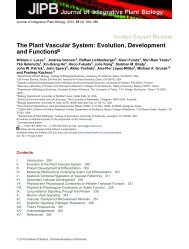Roles of SNARE Proteins in Synaptic Vesicle Fusion - Department of ...
Roles of SNARE Proteins in Synaptic Vesicle Fusion - Department of ...
Roles of SNARE Proteins in Synaptic Vesicle Fusion - Department of ...
You also want an ePaper? Increase the reach of your titles
YUMPU automatically turns print PDFs into web optimized ePapers that Google loves.
46 M.T. Palfreyman, E.M. Jorgensen<br />
It is likely that more than one core complex is required to catalyze fusion. Like<br />
viral fusion prote<strong>in</strong>s, the <strong>SNARE</strong>s used <strong>in</strong> exocytosis also seem to work as higher<br />
order multimers (121). Thus, a r<strong>in</strong>g <strong>of</strong> <strong>SNARE</strong>s could <strong>in</strong>duce a controlled local<br />
disruption <strong>of</strong> lipids. One possibility is that the hemifusion diaphragm would be<br />
del<strong>in</strong>eated by a r<strong>in</strong>g <strong>of</strong> <strong>SNARE</strong> transmembrane doma<strong>in</strong>s (84,121). Alternatively, it<br />
has been suggested that the transmembrane doma<strong>in</strong>s <strong>of</strong> the <strong>SNARE</strong>s might serve as<br />
a prote<strong>in</strong>aceous pore (122). Though the <strong>in</strong>teractions are quite weak (123), it has<br />
been shown that both syntax<strong>in</strong> and synaptobrev<strong>in</strong> form higher order multimers via<br />
conserved regions located <strong>in</strong> their transmembrane doma<strong>in</strong>s (124–127). Electron<br />
microscopy has provided images <strong>of</strong> these multimers and shows that they form starshaped<br />
structures with the transmembrane doma<strong>in</strong>s at the vertex (128). In vivo evidence<br />
for the existence <strong>of</strong> such multimers comes from the cooperative action <strong>of</strong> the<br />
<strong>SNARE</strong>s and dose dependency <strong>of</strong> <strong>in</strong>hibition by botul<strong>in</strong>um neurotox<strong>in</strong>s and <strong>SNARE</strong><br />
peptide blockers (121,129–132). Together, the evidence has suggested multimers<br />
conta<strong>in</strong><strong>in</strong>g from between three and 15 complexes (121). Nonetheless, work<strong>in</strong>g<br />
models for multimerization are currently quite prelim<strong>in</strong>ary; it will rema<strong>in</strong> to be seen<br />
how these multimers might aid <strong>in</strong> catalyz<strong>in</strong>g fusion.<br />
The Reliable Opposition: Prote<strong>in</strong> Models for the <strong>Fusion</strong> Pore<br />
Despite the appeal and considerable evidence for a lipidic fusion pore, there rema<strong>in</strong><br />
data suggest<strong>in</strong>g that the fusion pore could be prote<strong>in</strong>aceous (133). First, it has been<br />
proposed that the <strong>SNARE</strong>s are the fusogen but that the pore is l<strong>in</strong>ed by the transmembrane<br />
<strong>of</strong> the five to eight syntax<strong>in</strong> molecules rather than by lipids (122). This<br />
model derived from the observation that the replacement <strong>of</strong> residues <strong>in</strong> the transmembrane<br />
doma<strong>in</strong> <strong>of</strong> syntax<strong>in</strong> with bulky am<strong>in</strong>o acids slowed the conductance <strong>of</strong><br />
the <strong>in</strong>itial fusion pore. Second, some data <strong>in</strong>dicate that <strong>SNARE</strong>s were not <strong>in</strong>volved<br />
<strong>in</strong> the fusion step. NSF disassembles <strong>SNARE</strong> complexes, yet <strong>in</strong> yeast overexpression<br />
<strong>of</strong> NSF (Sec18p) did not block vacuole fusion (134). Third, techniques that can<br />
detect early stages <strong>of</strong> pore formation, amperometry, and capacitance measurements<br />
<strong>in</strong>dicate that the fusion pore <strong>in</strong> chromaff<strong>in</strong> cells might be formed by a prote<strong>in</strong>. In<br />
these experiments the <strong>in</strong>itial fusion pore was found to have a pore size equivalent to<br />
a large ion channel (approximately 1 to 2 nm <strong>in</strong> diameter) (135). In addition, these<br />
<strong>in</strong>itial fusion pores “flickered” like ion channel fusion pores (132,135,136). Fourth,<br />
it has been proposed that the V o sector <strong>of</strong> the vacuolar ATPase could act as a prote<strong>in</strong>aceous<br />
fusion pore (137,138). In yeast, calcium and calmodul<strong>in</strong> might be required<br />
<strong>in</strong> a step after <strong>SNARE</strong> complex formation <strong>in</strong> the process <strong>of</strong> fusion (139). The target<br />
<strong>of</strong> calcium-calmodul<strong>in</strong> <strong>in</strong> this late step <strong>in</strong> fusion was identified as the V o sector <strong>of</strong> the<br />
vacuolar ATPase (137). Furthermore, analysis <strong>of</strong> Drosophila mutants <strong>in</strong>dicated that<br />
the vacuolar ATPase was important for fusion <strong>of</strong> synaptic vesicles (140).<br />
Nonetheless, several po<strong>in</strong>ts are difficult to reconcile with a prote<strong>in</strong> pore–based<br />
model for fusion. First, trans <strong>SNARE</strong> complexes are resistant to the action <strong>of</strong> NSF,<br />
suggest<strong>in</strong>g that functional <strong>SNARE</strong>s were still present <strong>in</strong> yeast experiments (141).<br />
Wang_Ch03.<strong>in</strong>dd 46 5/15/2008 5:27:14 PM
















